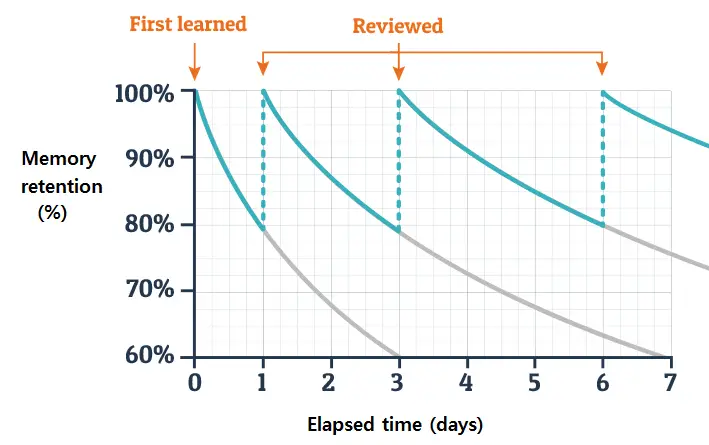Forgetting
Forgetting is the loss of learned information over time. If the human memory Opens in new window system were capable of retaining all of its stored memories perfectly and permanently, there would be little to find out about the memory process.
The fact that our memories often fail us is the main reason why psychologists have devoted effort to investigate the forgetting process. Of course, it is from studying the failure of memory that so much is revealed about how memory works.
Forgetting is basically a failure of memory. However, we can only say something has been forgotten if we had actually stored it in our memory in the first place. Bearing this in mind, Endel Tulving (1973, p. 74) defined
Forgetting as ‘the inability to recall something now that could be recalled on an earlier occasion’.
Similarly, forgetting is in this fashion defined as the inability to retrieve information at a certain point in time that could be retrieved at a previous time.
Memory is generally regarded as having three main stages, which are:
- Input (Encoding),
- Storage (Maintenance), and
- Output (Retrieval)
Forgetting occurs at the storage and output stages, but arguably not during input. If an item was not properly learned and encoded at the input stage, then the inability to retrieve it at some later point in time is not really caused by forgetting, but by a failure to learn it in the first place.
Forgetting can therefore involve a failure of the storage process or a failure of retrieval.
In practice, however, most forgetting in healthy people is probably caused by retrieval failure. The memory storage system seems to be fairly robust. However, it can fail when the brain suffers some kind of damage, as in the case of organic amnesia Opens in new window.
People have long been aware that they tend to forget things as time goes by. Ebbinghaus (1885) carried out the first truly scientific studies of memory performance, and he confirmed that forgetting appears to be time dependent, as shown in his well-known forgetting curve.
The classic forgetting curve Opens in new window (as shown in Figure X-1) involves very rapid forgetting at first, but at longer retention intervals the rate of forgetting levels off.
 Figure X-1 | Ebbinghaus' forgetting curve and review cycle. Source: ResearchGate Opens in new window
Figure X-1 | Ebbinghaus' forgetting curve and review cycle. Source: ResearchGate Opens in new window |
Ebbinghaus (1885) used meaningless nonsense syllables in his research, and he adopted the dubious approach of having only one participant (himself).
Admittedly, subsequent studies involving more appropriate numbers of participants have confirmed the same general shape of forgetting curve for many other types of test material.
However, more recent studies have shown that repeated testing of the same material with the same participants sometimes shows no decline in memory performance over time (Erdelyi & Becker, 1974; Roediger & Karpicke, 2006).
In some cases, memory actually improves with time if tested repeatedly.
Some test items may be recalled in a later test session which could not be recalled earlier (a phenomenon known as reminiscence), and in some cases there may actually be an overall improvement in memory performance over time (known as hypermnesia).
In these cases, it would appear that some of the memories that seemed to have been forgotten had not actually been lost from storage, but had just become temporarily inaccessible.
One possible explanation for the above findings is that there may be a limit on how much we can retrieve at one moment in time, thus causing a temporarily bottleneck in the retrieval system which will subsequently pass.
Alternatively, it is possible that some form of inhibitory mechanism may have suppressed the item for a short time, the effect of which will subsequently diminish.
Another possible explanation for forgetting is that the human brain lacks the ability to remember Opens in new window huge numbers of memories, and that is the main reason for forgetting. However, that claim is debatable.
It has been estimated that the human brain has approximately 80–90 billion neurons (Azevedo et al., 2009). If only 10% of those neurons were used to store memories, then hypothetically we might be able to store one billion individual memories (Richards & Frankland, 2017).
Regardless of the explanation, the occurrence of reminiscence and hypermnesia is consistent with the view that memory loss is often caused by retrieval failure rather than the complete loss of the forgotten item from the memory store.
These studies also demonstrate that memory is greatly enhanced by repeated testing and retrieval, the so-called ‘testing effect’ which was mentioned earlier.
See also:
- Baddeley, A. D., Eysenck, M. W., & Anderson, M. C. (2020). Memory (3rd edn). Abingdon: Psychology Press.
- Eysenck, M. W., & Keane, M. T. (2020). Cognitive Psychology: A student’s handbook (8th edn). Abingdon: Psychology Press.
- Groome, D. H. (2020). An Introduction to Cognitive Psychology: Processes and disorders (4th edn). Hove: Psychology Press.

